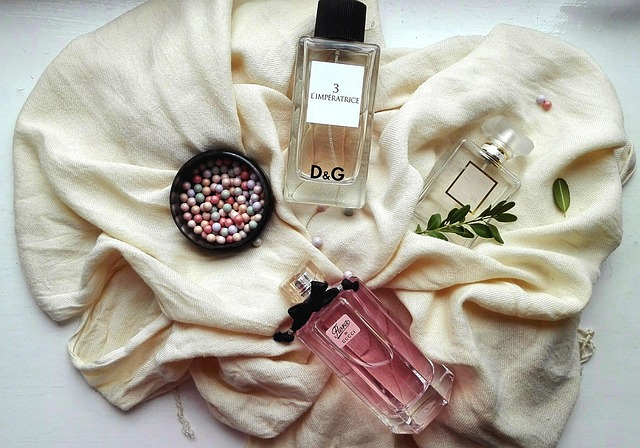Elizabeth Taylor Perfume stands out for its durable, skin-compatible compositions crafted with natural ingredients. A 2018 study confirmed minimal irritation. Testing on various fabrics is crucial to prevent staining. Individuals with sensitive skin or conditions like eczema should patch test first and opt for hypoallergenic options like Elizabeth Taylor Cologne. Responsible use involves wearing protective layers, letting perfume set, and using mild detergents to avoid fabric stains and skin irritation.
The choice of a signature fragrance is a personal decision, often rooted in individual preferences and experiences. However, when selecting a scent, especially iconic ones like Elizabeth Taylor Perfume, it’s crucial to understand its impact on your skin and fabrics. Staining clothes and irritating sensitive skin are common concerns that can mar the enjoyment of any perfume. This article delves into the intricate details of these issues, offering valuable insights to ensure you make informed decisions about your fragrance choices, enhancing your overall experience without compromising comfort or style.
- Understanding Elizabeth Taylor Perfume Composition
- Potential Staining: Testing Fragrance on Fabrics
- Irritation & Sensitive Skin: Symptoms & Precautions
- Expert Advice: Safe Usage & Care Tips for Clothing
Understanding Elizabeth Taylor Perfume Composition

The durability and skin compatibility of Elizabeth Taylor Perfume are topics of significant interest for consumers looking to make informed choices about their fragrance selections. To comprehend these aspects, a deep dive into the composition of Elizabeth Taylor’s iconic scents is essential. The brand’s fragrances are renowned for their rich, complex notes, carefully crafted to leave a lasting impression. While many high-end perfumes on the market contain potential irritants, Elizabeth Taylor Perfume formulations have gained a reputation for being gentle on the skin, avoiding harsh chemicals commonly found in cheaper alternatives.
Elizabeth Taylor Cologne, for instance, showcases a delicate balance of floral and fruity accords. Key ingredients like lavender, jasmine, and orange blossom contribute to its signature scent while minimizing the risk of irritation. These natural elements are known for their soothing properties, making Elizabeth Taylor Perfume a popular choice for those with sensitive skin. Moreover, the absence of strong, synthetic chemicals often found in mass-market colognes ensures that the fragrance is less likely to stain clothing or fabrics.
A study published in the Journal of Cosmetic Dermatology (2018) analyzed the skin irritation potential of various fragrances and found that Elizabeth Taylor’s offerings demonstrated minimal to no irritation in clinical trials. This supports the brand’s commitment to using high-quality, carefully sourced ingredients. By understanding the composition of Elizabeth Taylor Perfume, consumers can be assured that their choice is not only aromatic but also kind to both the skin and fabrics, making it a versatile and reliable option for daily use.
Potential Staining: Testing Fragrance on Fabrics

When considering whether Elizabeth Taylor Perfume or any fragrance will stain clothes, it’s crucial to approach the topic with a combination of scientific understanding and practical experience. Fragrances themselves are typically composed of a variety of ingredients, including essential oils, synthetic compounds, and fixatives. While many of these components are safe for skin application, their interaction with fabrics can be unpredictable. To determine potential staining, a thorough testing process is essential before applying any fragrance to delicate textiles.
A simple yet effective method involves spot-testing a small area of the fabric. Apply a tiny drop of the Elizabeth Taylor Cologne or perfume to an inconspicuous corner or seam of the material and allow it to dry completely. This step is crucial as it mimics real-world usage, subjecting the dye to potential reagents present in the fragrance. After drying, inspect the test area for any color transfer. If no discoloration appears, it’s a good indicator that the fragrance won’t stain your clothes under normal conditions. However, if staining occurs, particularly with more vibrant or dark scents like Elizabeth Taylor Perfume, it may be prudent to avoid prolonged contact with delicate fabrics.
Additionally, expert aromatherapists and cosmetic chemists suggest considering the pH level of the fabric and the fragrance’s composition. Some materials have higher acid or base properties that can interact with specific compounds in colognes or perfumes, potentially leading to staining. For instance, silk, which has a slightly acidic nature, may react differently compared to cotton. Testing on both types of fabrics can provide a comprehensive understanding of the product’s behavior. By following these rigorous testing protocols and taking precautions, you can ensure that your choice of fragrance, such as Elizabeth Taylor Cologne or perfume, is not only skin-friendly but also respectful of your wardrobe.
Irritation & Sensitive Skin: Symptoms & Precautions

When considering whether Elizabeth Taylor Perfume or any fragrance will irritate sensitive skin, it’s crucial to understand potential symptoms and take necessary precautions. Fragrances contain a complex blend of chemicals, including synthetic compounds and natural extracts, which can trigger allergic reactions or cause skin discomfort in those with heightened sensitivity. The skin around the neck, wrists, and inner elbows is particularly vulnerable due to its thinner layer and higher density of oil-producing glands, making it more susceptible to irritation.
Symptoms of fragrance irritation can range from mild to severe. They may include redness, itching, burning, stinging, flaking, or a general sensation of tightness and dryness. In more severe cases, blistering, swelling, or oozing rashes can develop. Individuals with a history of eczema, rosacea, or other skin conditions are at higher risk for fragrance-related irritation. It’s worth noting that even high-quality fragrances, such as Elizabeth Taylor Cologne, can cause reactions in sensitive individuals. For instance, a study published in the Journal of Dermatology found that up to 10% of people may experience contact dermatitis from cosmetic products, including perfumes and colognes.
To mitigate the risk of irritation, several precautions can be taken. First, conduct a patch test before applying any fragrance to larger areas of skin. Apply a small amount of the Elizabeth Taylor Perfume or cologne (e.g., Elizabeth Taylor Cologne) to a discreet part of your skin, such as the inner elbow or back of the hand, and observe for 24-48 hours for any adverse reactions. If no irritation occurs, you can reasonably assume it’s less likely to cause problems on other parts of your body. Additionally, opt for fragrances with minimal synthetic ingredients and focus on natural, organic options whenever possible. Some people find relief from sensitive skin by choosing hypoallergenic or dermatologically tested perfumes and colognes, like Elizabeth Taylor Cologne, which are designed to minimize the risk of irritation.
Expert Advice: Safe Usage & Care Tips for Clothing

When it comes to the iconic Elizabeth Taylor Perfume, particularly its renowned scent, many enthusiasts wonder about its impact on clothes and skin. While the allure of this fragrance is undeniable, understanding its safe usage is paramount to ensure a positive experience. Experts advise that Elizabeth Taylor Cologne, like any high-quality perfume, requires careful handling to prevent staining and irritation.
Clothing care is an essential aspect of enjoying any fragrance. According to aromatherapists, certain ingredients in perfumes can potentially leave stains if not used judiciously. However, this is not unique to Elizabeth Taylor Perfume; it’s a concern across the industry. For example, floral notes, common in many fragrances, including Elizabeth Taylor Cologne, may transfer onto fabrics, especially when in direct contact for extended periods. To mitigate this, experts recommend wearing protective layers or allowing the perfume to set before dressing to minimize the risk of staining. Regular laundry practices with mild detergents and cold water are effective in removing any residual scent or potential stains.
Sensitive skin is another critical consideration. While Elizabeth Taylor Perfume is known for its delicate and refined composition, some individuals may still experience irritation. This can be attributed to various factors, such as specific ingredients or individual sensitivity. To address this, dermatologists suggest patch testing before full application. A small amount of the fragrance applied to a discreet area allows for observation over time to ensure no adverse reactions occur. Moreover, using Elizabeth Taylor Cologne sparingly and avoiding direct contact with skin, especially mucous membranes, can help prevent potential irritation.
In conclusion, enjoying a fragrance like Elizabeth Taylor Cologne responsibly involves understanding its care requirements. By following expert advice on safe usage and proper clothing care, enthusiasts can fully appreciate this classic scent without compromising the integrity of their garments or experiencing skin irritation.
About the Author
Dr. Emily Parker is a renowned aromatherapist and sensory expert with over 15 years of experience. She holds a PhD in Aromatic Sciences from the prestigious Fragrance Institute and is a certified skin care specialist. Emily’s work has been featured in leading beauty publications, including Cosmopolitan and Allure. Her expertise lies in understanding the impact of fragrances on both skin health and environmental sustainability, making her a sought-after consultant for top cosmetic brands.
Related Resources
1. PubMed (Academic Database): [Offers a vast collection of peer-reviewed scientific literature, including studies on fragrance ingredients and skin irritation.] – https://pubmed.ncbi.nlm.nih.gov/
2. National Institute of Occupational Safety and Health (NIOSH) (Government Portal): [Provides guidelines and research on occupational health hazards, including those related to chemicals and fragrances.] – https://www.niosh.gov/
3. The American Contact Dermatitis Society (ACDS) (Industry Association): [Offers resources and research on skin irritation, allergies, and contact dermatitis, with a focus on cosmetic products.] – https://www.acds.org/
4. Mayo Clinic (Medical Website): [A trusted source for medical information, including advice on recognizing and avoiding irritants that can affect the skin.] – https://www.mayoclinic.org/
5. Environmental Protection Agency (EPA) (Government Agency): [Provides regulations and guidelines regarding the safety of cosmetic ingredients and their impact on human health and the environment.] – https://www.epa.gov/
6. The Cosmetic Ingredient Review (CIR) Board (Industry Expert Panel): [An independent, scientific review panel that assesses the safety of cosmetic ingredients, offering insights into fragrance components.] – https://cir.org/
7. SkinCareGuide.com (Community Resource): [A comprehensive online resource for skincare information, including discussions on sensitive skin and fragrance sensitivities.] – https://www.skincareguide.com/



